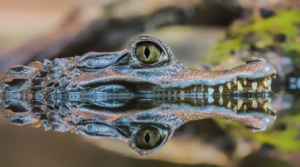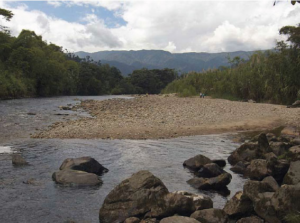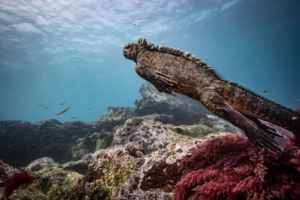Humpback whales are the most acrobatic and agile aquatic mammals in the world, their dances of courtship stand out during their reproductive season, emitting beautiful songs, which according to scientists can last from 10 – 20 minutes or can last for hours.
Like other marine mammals, the humpback whale (Megaptera novaeangliae) has been commercially overexploited to the point of near extinction. The species though is protected. The International Whaling Commission (IWC) has protected the species since 1966.
Its body is robust, compared to that of other balenopterygids, and thins abruptly towards the ends. Adult females have an average length of 15 m and a maximum length of 19 m.of 19 m. Adult males have an average length of 14 m, with a maximum of 17.5 m. These animals weigh between 30 – 40 tons reaching a maximum of 53 tons.
Humpback whales use a feeding repertoire. This development of specialized behaviors, which are culturally inherited, includes:
1) individual ramming near the surface, which may be by swimming on the side, common among
2) the use of clouds, columns, or bubble nets that concentrate the krill (planktonic crustaceans)
3) the use of clouds, columns or bubble nets that concentrate krill and fish that are rammed by swimming vertically towards the surface;
4) the stunning of prey by flapping fins
5) the stunning of prey by finning and tailing
6) the use of the water’s surface to prevent
Migration in Ecuador
Humpback whale populations around the world appear to be recovering. The whale watching season is from June – September, also these wonderful cetaceans are attracted by the warm waters of Machalilla National Park in Puerto Lopez Manabi.
They mate during the winter and in the Northern Hemisphere, this occurs between December and March. The sex ratio in the feeding grounds appears to be balanced, but in breeding grounds, adult and juvenile females and juveniles make up 25 – 40% because many females do not leave the feeding grounds during the winter, and do not reach the breeding destinations or remain there for a The proportion of the time.
The arrival of the whales occurs in groups, the young males are the first to make their way to the coast in early June, followed by the adult males and finally females come at the end of July.
The best season for whale watching
June to October is prime time for whale watching in Ecuador. Thankfully for those on a budget, you won’t even need to visit the Galapagos Islands. The infrastructure for seeing whales in Ecuador is even better along the northern coast of the mainland, meaning you can view wildlife from boat trips, paddle boards, and even the mainland, all without blowing the budget.
During the summer months, more than 7,000 humpback whales pass by the triangle of shallow water between Puerto Lopez – Isla de la Plata – Manta, making it one of the best whale watching locations in Ecuador, and the world. From Puerto Lopez, whale watching tours are organized where you venture out in small boats finding and admiring the whales from up close for about 2 hours.
Tips for whale watching in Ecuador
- Get the season right. If you visit Ecuador between November and May, it’s unlikely you’ll see any whales.
- Don’t forget your camera! If you have a great zoom lens, you can use it to capture photos of whales from afar.
- Patience is key. Whenever interacting with wild animals, they’re in control. Don’t be disheartened if you don’t see whales right away. Tours give you a whale-watch guarantee, you’ll definitely get to see them.
- Bring the right kit Don’t forget sunscreen, a hat, and a pullover: a seemingly cloudy day can turn further in the sea into the baking sun, and a warm day can make you shiver on the boat.
- If you are the adventurous type, avoid the tourist tours and go to a hill point for a more intimate encounter. The one at Punta La Barca in Santa Marianita rents out Stand Up Paddle to get closer on your own. It is also the perfect spot to go out on a kitesurf and follow the whales around. Be cautious though and keep always your distance, (about 20 meters is recommended). The whales are curious and never attack, but an accidental sweep of their tail could probably kill a person.
Introduction
Humpback whales are the most acrobatic and agile aquatic mammals in the world, their dances of courtship stand out during their reproductive season, emitting beautiful songs, which according to scientists can last from 10 – 20 minutes or can last for hours.
Like other marine mammals, the humpback whale (Megaptera novaeangliae) has been commercially overexploited to the point of near extinction. The species though is protected. The International Whaling Commission (IWC) has protected the species since 1966.
Its body is robust, compared to that of other balenopterygids, and thins abruptly towards the ends. Adult females have an average length of 15 m and a maximum length of 19 m.of 19 m. Adult males have an average length of 14 m, with a maximum of 17.5 m. These animals weigh between 30 – 40 tons reaching a maximum of 53 tons.
Humpback whales use a feeding repertoire. This development of specialized behaviors, which are culturally inherited, includes:
1) individual ramming near the surface, which may be by swimming on the side, common among
2) the use of clouds, columns, or bubble nets that concentrate the krill (
3) the use of clouds, columns or bubble nets that concentrate krill and fish that are rammed by swimming vertically towards the surface;
4) the stunning of prey by flapping fins
5) the stunning of prey by finning and tailing;
6) the use of the water’s surface to prevent
Migration in Ecuador
Humpback whale populations around the world appear to be recovering. The whale watching season is from June to September, these wonderful cetaceans are attracted by the warm waters of Machalilla National Park in Puerto Lopez Manabi.
It mate during the winter and in the Northern Hemisphere this occurs Northern Hemisphere this occurs between December and March. The sex ratio in the feeding grounds appears to be balanced, but in the balanced, but in the breeding grounds, adult and juvenile females females and juveniles make up 25 – 40% because many females do not leave the because many females do not leave the feeding grounds during the winter during the winter, do not reach the breeding destinations or remain there for a The proportion of mature of mature females is 25%.
The arrival of the whales occurs in groups, the young males are the first to make their way to the coast in early June, followed by the adult males and finally females come the end of July.
The best season for whale watching
June to October is prime time for whale watching in Ecuador. Thankfully for those on a budget, you won’t even need to visit the Galapagos Islands. The infrastructure for seeing whales in Ecuador is even better along the northern coast of the mainland, meaning you can view wildlife from boat trips, paddle boards, and even the mainland, all without blowing the budget. During the summer months, more than 7,000 humpback whales pass by the triangle of shallow water between Puerto Lopez – Isla de la plata – Manta, making it one of the best whale watching locations in Ecuador, as well as the world. From Puerto Lopez, whale whatching tours are organized where you go out in small boats finding and admiring the whales from up close for about two hours.
Tips for whale watching in Ecuador
- Get the season right. If you visit Ecuador between November and May, it’s unlikely you’ll see any whales.
- Don’t forget your camera! If you have a great zoom, use it to capture photos of whales from afar.
- Patience is key. Whenever interacting with wild animals, they’re in control. Don’t be disheartened if you don’t see whales straight away. Tours give you a whale-watch guarentee, you’ll definitely get to see them.
- Bring the right kit Don’t forget sunscreen, a hat, and a pullover: a seemingly cloudy day can turn furthen in sea into the baking sun, and a warm day can make you shiver on the boat.
- If you are the adventurous type, avoid the tourist tours and go to a hill point for a more intimate encounter. The one at Punta La Barca in Santa Marianita rents out Stand Up Paddle to get closer on your own. It is also the perfect spot to go out on a kitesurf and follow the whales around. Be cautious though and keep always your distance, 20 meters is recommended. The whales are curious and never attack, but an accidental sweep of their tail could probably kill a person.
Introduction
Humpback whales are the most acrobatic and agile aquatic mammals in the world, their dances of courtship stand out during their reproductive season, emitting beautiful songs, which according to scientists can last from 10 – 20 minutes or can last for hours.
Like other marine mammals, the humpback whale (Megaptera novaeangliae) has been commercially overexploited to the point of near extinction. The species though is protected. The International Whaling Commission (IWC) has protected the species since 1966.
Its body is robust, compared to that of other balenopterygids, and thins abruptly towards the ends. Adult females have an average length of 15 m and a maximum length of 19 m.of 19 m. Adult males have an average length of 14 m, with a maximum of 17.5 m. These animals weigh between 30 – 40 tons reaching a maximum of 53 tons.
Humpback whales use a feeding repertoire. This development of specialized behaviors, which are culturally inherited, includes:
1) individual ramming near the surface, which may be by swimming on the side, common among
2) the use of clouds, columns, or bubble nets that concentrate the krill
3) the use of clouds, columns or bubble nets that concentrate krill and fish that are rammed by swimming vertically towards the surface;
4) the stunning of prey by flapping fins, which is
5) the stunning of prey by finning and tailing;
6) the use of the water’s surface to prevent
Migration in Ecuador
Humpback whale populations around the world appear to be recovering. The whale watching season is from June to September, these wonderful cetaceans are attracted by the warm waters of Machalilla National Park in Puerto Lopez Manabi.
It mate during the winter and in the Northern Hemisphere this occurs Northern Hemisphere this occurs between December and March. The sex ratio in the feeding grounds appears to be balanced, but in the balanced, but in the breeding grounds, adult and juvenile females females and juveniles make up 25 – 40% because many females do not leave the because many females do not leave the feeding grounds during the winter during the winter, do not reach the breeding destinations or remain there for a The proportion of mature of mature females is 25%.
The arrival of the whales occurs in groups, the young males are the first to make their way to the coast in early June, followed by the adult males and finally females come the end of July.
The best season for whale watching
June to October is prime time for whale watching in Ecuador. Thankfully for those on a budget, you won’t even need to visit the Galapagos Islands. The infrastructure for seeing whales in Ecuador is even better along the northern coast of the mainland, meaning you can view wildlife from boat trips, paddle boards, and even the mainland, all without blowing the budget. During the summer months, more than 7,000 humpback whales pass by the triangle of shallow water between Puerto Lopez – Isla de la plata – Manta, making it one of the best whale watching locations in Ecuador, as well as the world. From Puerto Lopez, whale whatching tours are organized where you go out in small boats finding and admiring the whales from up close for about two hours.
Tips for whale watching in Ecuador
- Get the season right. If you visit Ecuador between November and May, it’s unlikely you’ll see any whales.
- Don’t forget your camera! If you have a great zoom, use it to capture photos of whales from afar.
- Patience is key. Whenever interacting with wild animals, they’re in control. Don’t be disheartened if you don’t see whales straight away. Tours give you a whale-watch guarentee, you’ll definitely get to see them.
- Bring the right kit Don’t forget sunscreen, a hat, and a pullover: a seemingly cloudy day can turn furthen in sea into the baking sun, and a warm day can make you shiver on the boat.
- If you are the adventurous type, avoid the tourist tours and go to a hill point for a more intimate encounter. The one at Punta La Barca in Santa Marianita rents out Stand Up Paddle to get closer on your own. It is also the perfect spot to go out on a kitesurf and follow the whales around. Be cautious though and keep always your distance, 20 meters is recommended. The whales are curious and never attack, but an accidental sweep of their tail could probably kill a person.
Introduction
Humpback whales are the most acrobatic and agile aquatic mammals in the world, their dances of courtship stand out during their reproductive season, emitting beautiful songs, which according to scientists can last from 10 – 20 minutes or can last for hours.
Like other marine mammals, the humpback whale (Megaptera novaeangliae) has been commercially overexploited to the point of near extinction. The species though is protected. The International Whaling Commission (IWC) has protected the species since 1966.
Its body is robust, compared to that of other balenopterygids, and thins abruptly towards the ends. Adult females have an average length of 15 m and a maximum length of 19 m.of 19 m. Adult males have an average length of 14 m, with a maximum of 17.5 m. These animals weigh between 30 – 40 tons reaching a maximum of 53 tons.
Humpback whales use a feeding repertoire. This development of specialized behaviors, which are culturally inherited, includes:
1) individual ramming near the surface, which may be by swimming on the side, common among
2) the use of clouds, columns, or bubble nets that concentrate the krill
3) the use of clouds, columns, or bubble nets that concentrate krill and fish that are rammed by swimming vertically towards the surface;
4) the stunning of prey by flapping fins, which is
5) the stunning of prey by finning and tailing;
6) the use of the water’s surface to prevent
Migration in Ecuador
Humpback whale populations around the world appear to be recovering. The whale watching season is from June to September, these wonderful cetaceans are attracted by the warm waters of Machalilla National Park in Puerto Lopez Manabi.
It is made during the winter and in the Northern Hemisphere, this occurs between December and March. The sex ratio in the feeding grounds appear to be balanced, but in the balanced, but breeding grounds, adult and juvenile females and juveniles makeup 25 – 40% because many females do not leave the feeding grounds during the winter, and do not reach the breeding destinations or remain there for a The proportion of mature females is 25%.
The arrival of the whales occurs in groups, the young males are the first to make their way to the coast in early June, followed by the adult males and finally females come at the end of July.
The best season for whale watching
June to October is prime time for whale watching in Ecuador. Thankfully for those on a budget, you won’t even need to visit the Galapagos Islands. The infrastructure for seeing whales in Ecuador is even better along the northern coast of the mainland, meaning you can view wildlife from boat trips, paddle boards, and even the mainland, all without blowing the budget. During the summer months, more than 7,000 humpback whales pass by the triangle of shallow water between Puerto Lopez – Isla de la Plata – Manta, making it one of the best whale watching locations in Ecuador, as well as the world. From Puerto Lopez, whale watching tours are organized where you go out in small boats finding and admiring the whales from up close for about two hours.
Tips for whale watching in Ecuador
- Get the season right. If you visit Ecuador between November and May, it’s unlikely you’ll see any whales.
- Don’t forget your camera! If you have a great zoom, use it to capture photos of whales from afar.
- Patience is key. Whenever interacting with wild animals, they’re in control. Don’t be disheartened if you don’t see whales straight away. Tours give you a whale-watch guarantee, you’ll get to see them.
- Bring the right kit Don’t forget sunscreen, a hat, and a pullover: a seemingly cloudy day can turn the further sea into the baking sun, and a warm day can make you shiver on the boat.
- If you are the adventurous type, avoid the tourist tours and go to a hill point for a more intimate encounter. The one at Punta La Barca in Santa Marianita rents out Stand Up Paddle to get closer on your own. It is also the perfect spot to go out on a kitesurf and follow the whales around. Be cautious though and keep always your distance, 20 meters is recommended. The whales are curious and never attack, but an accidental sweep of their tail could probably kill a person.




